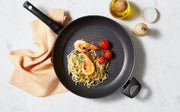The Do's and Don'ts of Wooden Cheese Boards

In Frame: Peer Sorensen - Acacia Long Grain Cutting Board
Whether it's a picnic, dinner party, or a fun BBQ, special occasions call for a fun cheese platter! There's something special in having your own wooden serving board – not only is it the most stunning way to serve snacks and cheese, but it's also an awesome conversation starter and makes for a great centrepiece.
When it comes to owning or caring for a wooden board, though, you might have a set of questions. What should you do and not do? Here are our tips and tricks for lasting care and proper use of your wooden cheese board!
______________________________________
Do: Oil your wooden cheese board before first use
So you bought your first wooden serving board, and can't wait to make use of its gorgeous, rustic look. But before using your board for the first time, you will definitely want to oil it.
It's similar to seasoning your cast iron skillet. Adding a protective layer of oil on top of your wood will keep it safe from moisture and even more long-lasting. Best quality wooden cheese boards are often made of materials like mango or acacia wood, so oiling a wooden board — and this applies for both cheese and chopping boards — is crucial to protect its precious material.
It would also help add an extra layer between your food and the grain of the wood, to prevent smells or moisture from seeping through.
Do: Use the right oil for your wooden cheese board
The good news is you don't always need a fancy wood balm to get the job done! A good food-safe mineral oil is reliable enough to keep even your large wooden cheese boards looking fresh and clean. You can also use something like our Wood Oil spray from Scanpan, which is ideal for maintaining wood or bamboo surfaces.
Don't: Use olive or vegetable oils for your wooden board
That being said, don't just use any oil for oiling your wooden serving board. Oils with specific smells such as olive or vegetable oil can get rancid over time, which might affect your board and cause it to smell bad! Best to keep it safe with those mineral oils instead.

Don't: Soak your wooden board
When it comes to washing your cheese board, especially with water, you want to keep it quick. Most of the time you can get away with wiping it clean, but if it does require that extra wash, use hot water and a small amount of mild dish soap. (Stay away from harsh detergents!) Then, gently rub in circular motions with a soft sponge — you should not use abrasive scourers on your board
If there are stains or smells you need to get rid of, you can use a 2:1 mixture of water and vinegar. Alternatively, sprinkle your board with some salt and then rub it with a lemon cut in half; the lemon juices will help get rid of any remaining odour.
Do: Dry your wooden cheese board thoroughly
Natural wood has pores, which means we need to prevent it from absorbing water wherever possible. Any moisture trapped inside can potentially harm the wood. So after you wash your board, be sure to wipe or press it with a dry cloth or paper towel. Water dries out wood, so once your wooden board is dry, you'd want to apply another small amount of oil to keep it from cracking or warping.
Don't: Put your wooden board in a dishwasher
This goes without saying — but do not put a wooden board into a dishwasher! That amount of water, along with extreme dishwasher heat, can seriously stress out your board and dry out its material. So take that little extra time to hand-wash your precious boards to ensure they stay in your home for a really long time!
Do: Seal your cheese board regularly
Many also recommend oiling your cheese board at least once a month — a process called sealing. We do this by oiling the entire surface of our board (some people use a combination of beeswax & mineral oil) and using a soft cloth to wipe or polish it. Then we let that oil sit for a few hours, or even overnight. What this does is it keeps the surface of your board looking smooth and beautiful, and further prevents moisture from soaking in.

Don't: Store cheese boards in closed or damp spaces.
It's important to give your cheese board plenty of light and air flow by keeping it somewhere dry. Paddle boards can be a great option for storage, as you can hang them easily. In general, wooden boards are made of gorgeous material, so you can definitely display them as decor in your kitchen or on your table!
If you really want to stow them away, we recommend keeping them in a larger pantry with plenty of air flow to prevent too much humidity.
Do: Choose the right wooden cheese board
Now, your table and home deserves the best quality wooden cheese board there is. So, why not browse our best-selling collection? We offer some stunning pieces from Australia's best homeware brands, like Peer Sorensen and their range of acacia wood serving boards.
Acacia wood is a strong and elegant type of hardwood that grows in many parts around the world. This native Australian wood is solid and dense, which means it's particularly good for cutting boards or cheese boards.
You can also add style to your home with Ecology's Arcadian range, featuring pieces made of mango wood — perfect for serving cheese, cold meats, or even dessert spreads!
Wooden Cheese Board FAQ
1. Do I have to oil both sides of my wooden board?
There isn't as much need to oil both sides of your serving board, but it's good to apply every now and then (especially if it's frequently used or has been in contact with water).
2. What do I put on a cheese platter?
There are tons of ways you can be creative in terms of deciding what to put on a cheese plate. Generally, cheese boards are great for serving a variety of cheeses (go for 3 to 5 different types). Between parmesan, cheddar, gouda, brie, to goat cheese, you have plenty of options — but we recommend including both soft and hard cheeses on your board!
Other than that, you can put fresh berries, grapes, heirloom tomatoes, figs... To accompany your cheeses, you can put some good slices of meat like prosciutto or chorizo, coupled with some breadsticks or crackers. Nuts are also a popular option, like walnuts or pistachios. To step it up, you can even serve some homemade sauces and dips, such as fresh homemade pesto!
3. How long can I leave my cheese board out?
When you're serving cheeses to your guests, it's recommended that you keep them out no later than four hours. This is to keep your food & board safe from any bacteria or spoilage.

In Frame: Peer Sorensen Picnic Tables
So are you ready to welcome summer? There's no better way to enjoy the company of your loved ones than with an unforgettable charcuterie board!
Once you ace that cheese platter, we guarantee your friends will be talking about it for days. And with some good love and care, your board will last to serve you for many years to come!
Happy feasting!
Love,
The Matchbox Team


-2-v1632785434298.jpg?5984x3207)







